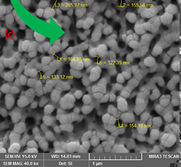Study Experimental and Numerical Simulations of the Micro-hardness Tests in AL-FE alloy in Different Laser Beam Scanning
Main Article Content
Keywords
Laser surface remelting, microstructural characteristics, FEG-EDS, micro-hardness, modeling indentation, FEM
Abstract
In the Al–2.0 wt.%Fe alloy the laser surface remelting (LSR) treatment was executed to investigate the treated and untreated layers areas, at different laser beam scanning, among them, 80, 100 and 120 mm/s, to respect, was presented and discussed about microstructural characteristics using the FEG and EDS techniques, and numerical experiments of pyramidal indentations of the LSR-treated systems were conducted using the FEM method. In the sample-treated cross-sectional area, the microstructure presented a columnar growth characteristic, a lot of nano-porosities and large size of the molten pool geometry in low laser beam scanning, however, in high laser beam scanning, the microstructure consisted of a cellular arrangement or fine-grained microstructure, the nano-porosities concentration and the molten pool geometry are slightly decreased. Besides, the micro-hardness in the LSR-treated area increased slightly as a function of increase of the laser beam scanning, but, the micro-hardness was much higher than the untreated sample. Meanwhile, modeling of indentation on COMSOL of the LSR-treatment by finite element method of the micro-hardness was successfully calculated. Therefore, a good agreement was found between experimental and simulated data.
Downloads
References
https://doi.org/10.1016/j.jallcom.2017.01.131
[2] T. Zienert and O. Fabrichnaya, “Experimental investigation and thermodynamic assessment of the al-fe system,” Journal of Alloys and Compounds, vol. 743, pp. 795 – 811, 2018. [Online]. Available: https://doi.org/10.1016/j.jallcom.2018.01.316
[3] K. Han, I. Ohnuma, and R. Kainuma, “Experimental determination of phase equilibria of al-rich portion in the al–fe binary system,” Journal of Alloys and Compounds, vol. 668, pp. 97 – 106, 2016. [Online]. Available: https://doi.org/10.1016/j.jallcom.2016.01.215
[4] S. Mukherjee, S. Chakraborty, R. Galun, Y. Estrin, and I. Manna, “Transport phenomena in conduction mode laser beam welding of fe–al dissimilar couple with ta diffusion barrier,” International Journal of Heat and Mass Transfer, vol. 53, no. 23, pp. 5274 – 5282, 2010. [Online]. Available: https://doi.org/10.1016/j.ijheatmasstransfer.2010.07.032
[5] P. R. Goulart, V. B. Lazarine, C. V. Leal, J. E. Spinelli, N. Cheung, and A. Garcia, “Investigation of intermetallics in hypoeutectic al–fe alloys by dissolution of the al matrix,” Intermetallics, vol. 17, no. 9, pp. 753 – 761, 2009. [Online]. Available: https://doi.org/10.1016/j.intermet.2009.03.003
[6] J. Swadener, E. George, and G. Pharr, “The correlation of the indentation size effect measured with indenters of various shapes,” Journal of the Mechanics and Physics of Solids, vol. 50, no. 4, pp. 681 – 694, 2002.
[Online]. Available: https://doi.org/10.1016/S0022-5096(01)00103-X
[7] J. Chen and S. Bull, “The investigation of creep of electroplated sn and ni–sn coating on copper at room temperature by nanoindentation,” Surface and Coatings Technology, vol. 203, no. 12, pp. 1609 – 1617, 2009. [Online]. Available: https://doi.org/10.1016/j.surfcoat.2008.12.007
[8] J. Bressan, A. Tramontin, and C. Rosa, “Modeling of nanoindentation of bulk and thin film by finite element method,” Wear, vol. 258, no. 1, pp. 115 – 122, 2005, second International Conference on Erosive and Abrasive Wear. [Online]. Available: https://doi.org/10.1016/j.wear.2004.05.021
[9] M. Fivel, L. Tabourot, E. Rauch, and E. Canova, “Identification through mesoscopic simulations of macroscopic parameters of physically based constitutive equations for the plastic behaviour of fcc single crystats,” J. Phys. IV France, vol. 08, pp. 151–158, 1998. [Online]. Available: https://doi.org/10.1051/jp4:1998819
[10] A. Abbo, “Finite element algorithms for elastoplasticity and consolidation,” Ph.D. dissertation, University of Newcastle, 2005.
[11] M. Kot, W. Rakowski, L. Major, and J. Lackner, “Load-bearing capacity of coating–substrate systems obtained from spherical indentation tests,” Materials & Design, vol. 46, pp. 751 – 757, 2013. [Online]. Available: https://doi.org/10.1016/j.matdes.2012.11.026
[12] A. S. Alaboodi and Z. Hussain, “Finite element modeling of nanoindentation technique to characterize thin film coatings,” Journal of King Saud University - Engineering Sciences, vol. 31, no. 1, pp. 61 – 69, 2019. [Online]. Available: https://doi.org/10.1016/j.jksues.2017.02.001
[13] P. S. Pandure, V. S. Jatti, and T. Singh, “Finite element simulation of nano-indentation of dlc coated hss substrate,” Procedia Materials Science, vol. 6, pp. 1619 – 1624, 2014, 3rd International Conference on Materials Processing and Characterisation (ICMPC 2014). [Online]. Available: https://doi.org/10.1016/j.mspro.2014.07.145
[14] S. M. Holzer and Z. Yosibash, “The p-version of the finite element method in incremental elasto-plastic analysis,” International Journal for Numerical Methods in Engineering, vol. 39, no. 11, pp. 1859–1878,
1996. [Online]. Available: 10.1002/(SICI)1097-0207(19960615)39:11<1859::AID-NME932>3.0.CO;2-7 62, 65
[15] K. Krabbenhøft, “Basic computational plasticity,” University of Denmark, 2002, department of Civil Engineering Technical. [Online]. Available: http://homes.civil.aau.dk/lda/continuum/plast.pdf
[16] D. J. Celentano, B. Guelorget, M. François, M. A. Cruchaga, and A. Slimane, “Numerical simulation and experimental validation of the microindentation test applied to bulk elastoplastic materials,” Modelling and Simulation in Materials Science and Engineering, vol. 20, no. 4, p. 045007, apr 2012. [Online]. Available: https://doi.org/10.1088/0965-0393/20/4/045007
[17] M. Pariona and T. Micene, “The alumina film nanomorphology formed to improve the corrosion resistance of al-2.0 wt% fe alloy as result of the laser surface melting technique,” Applied Advances in Chemical Engineering and Science, vol. 7, pp. 10–22, 2017. [Online]. Available: https://doi.org/10.4236/aces.2017.71002
[18] P. Goulart, “Characterization of the solidification microstructure of al-fe alloys and correlation in mechanical properties,” Ph.D. dissertation, Universidade Estadual de Campinas (UNICAMP), 2010.
[19] M. M. Pariona, V. Teleginski, K. dos Santos, S. Machado, A. J. Zara, N. K. Zurba, and R. Riva, “Yb-fiber laser beam effects on the surface modification of al–fe aerospace alloy obtaining weld filet structures, low fine porosity and corrosion resistance,” Surface and Coatings Technology, vol. 206, no. 8, pp. 2293 – 2301, 2012. [Online]. Available: https://doi.org/10.1016/j.surfcoat.2011.10.007
[20] M. M. Pariona, A. F. Taques, and L. A. Woiciechowski, “The marangoni effect on microstructure properties and morphology of laser-treated al-fe alloy with single track by fem: Varying the laser beam velocity,” International Journal of Heat and Mass Transfer, vol. 119, pp. 10 – 19, 2018. [Online]. Available: https://doi.org/10.1016/j.ijheatmasstransfer.2017.11.097
[21] J. Gallardo, L. Soria, and E. Herrera, “Investigation of service failures in automobile shock absorbers,” Engineering Failure Analysis, vol. 14, no. 2, pp. 355 – 363, 2007, papers presented at the 22nd meeting of the
Spanish Fracture Group (Almargro, Spain, March 2005). [Online]. Available: https://doi.org/10.1016/j.engfailanal.2006.02.006

